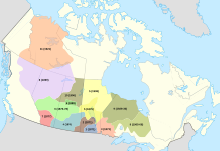David Laird
[2] David Laird attended the Presbyterian Theological Seminary in Truro, Nova Scotia, after which he planned to become a minister.
The first issue of The Protestant and Evangelical Witness in July 1859 proclaimed its purpose as "exposing the errors and noting the wiles and workings of popery."
[3] As the leader of the Prince Edward Island Liberal members of parliament, he refused to support Prime Minister John A. Macdonald during the "Pacific Scandal".
Laird warned the federal government of the problem: The threatened early extinction of the Buffalo is a question of grave importance to the North West Territories of the Dominion.
The traffic in Buffalo peltries likewise enters largely into the trade of the country, and enables the natives to procure many of the necessaries of life.By 1879 they had disappeared completely.
This council resolved: That the Conference having maturely considered the state of the Indians in the North-West Territories, and the sources from which they can supply themselves with food, is of opinion that the fears entertained of an approaching famine are only too well grounded, and that unless a very large supply of provisions is furnished by Government, for issue during the coming winter, a great number of Indians will be without the amount of food absolutely necessary to sustain life.
Should this state of affairs arise, and it appears to the Conference to be inevitable, it will be fraught with such dire consequences not only to the Indians themselves, but to the many settlers scattered throughout the Territories, that immediate steps should be taken to avert, if possible, so great a calamity.
Dyck (1970).The council ordered that large quantities of beef, bacon, flour, fish and pemmican be distributed at various points in the North-West.
It covered most of current day southern Saskatchewan, plus small portions of what are today western Manitoba and southeastern Alberta.
The Commissioners of the Queen were: the Honourable Alexander Morris, Lieutenant Governor of the Province of Manitoba and the North-West Territories; the Honourable David Laird, Minister of the Interior, and William Joseph Christie, Esquire, of Brockville, Ontario and retired Hudson's Bay Company factor for the Saskatchewan district.
David Laird's presence allowed Morris to negotiate confident that the federal government would support the results.
Treaty 5 (1875) involved the Saulteaux and Swampy Cree non-treaty tribes and peoples around Lake Winnipeg in the District of Keewatin.
Laird's interest was to get the native people to extinguish their claim to the land so that the incoming settlers could establish their own properties.
This included: the Lieutenant Governor for the region, Alexander Morris; Alfred Selwyn, the head of the Geological Survey working beyond the boundaries of Treaty Four; Lawrence Clarke, in charge of the Hudson's Bay Company's post of Fort Carlton; Commissioner French of the Mounted Police; and, Major-General Selby Smyth, the officer commanding the Canadian Militia.
He finally received permission to arrange for a treaty negotiation with the Saskatchewan Cree for the following summer at Forts Carlton and Pitt.
Laird relied on Morris to use his experienced judgment in arranging the terms of the treaty: "Your large experience and past success in conducting Indian negotiations relieves me from the necessity of giving you any detailed instructions in reference to your present mission."
In 1877, David Laird reported to the Superintendent General of Indian Affairs (SGIA) in Ottawa that most of the bands in Treaty 6 had been supplied with seed and were beginning to farm.
The agreement was signed at the Blackfoot Crossing of the Bow River, at the present-day Siksika Nation reserve, approximately 100 km east of Calgary.
...the true interests of the aborigines and of the State alike require that every effort should be made to aid the Red man in lifting himself out of his condition of tutelage and dependence, and that is clearly our wisdom and our duty, through education and every other means, to prepare him for a higher civilization by encouraging him to assume the privileges and responsibilities of full citizenship.
Twenty years after his first task to work with Plains Indigenous peoples, he was appointed Indian Commissioner of Manitoba, Keewatin and North-West Territories in 1898, and held that position until his death.
As Indian Commissioner for Manitoba and the North-West Territories, Laird offered a strongly worded negative opinion to the debate of establishing Treaty 8 in Northern Saskatchewan.
The matter, I suggest, may very well stand over for the present; and, when the autonomy question is settled in the Northwest Territories, if it is found that any Province, or organized territory with representation, extends over a considerable tract of country in which aboriginal title has not been extinguished, then in such case, or from the entrance of a railway, the discovery of mines, or other cause to bring an inrush of whites, a treaty should be made without delay.
Although early historians wrote positively of Laird's work with aboriginal people, he has not fared so well among more recent scholars.
Laird is acknowledged as hard-working and committed to negotiating treaties 4 through 7, but he viewed Indians as "improvident complainers, limited in intelligence," and "troublesome to deal with."
Laird's policy of denying Indians both land and skills left native youth with few resources for success.
[7] The inclusion of Prince Edward Island as a province of the Canadian federation is due, in part, to the negotiation skill of David Laird.
His accomplishments in the arena of aboriginal matters continue to influence the present relationship between the Canadian government and native peoples.
In North Battleford, Saskatchewan, James Marshall has produced "stunning" brick relief sculptures depicting the area's heritage.


